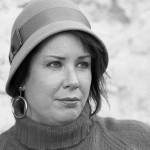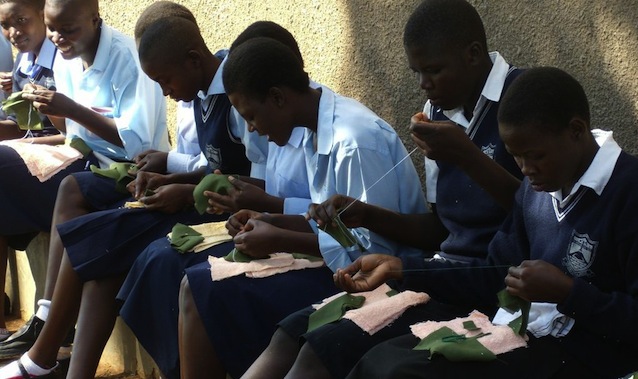By Rebecca L. Rhoades
In rural Uganda, where adequate menstrual supplies are either difficult to obtain or too expensive for the average family, it is not uncommon for girls to use rags, old socks, or even wads of newspapers to try to contain their period. And rather than risk the embarrassment of bleeding through their clothes or being teased by boys””menstruation is a taboo subject””many girls stay home from school during their cycle, eventually falling so far behind that they drop out of school altogether.
 Peace Corps volunteer Stacey Frankenstein-Markon, who served in the small town of Bukedea, about 150 miles northeast of Kampala, Uganda’s largest city and capital, was shocked to learn that young girls felt it necessary to stay home because they lacked appropriate feminine protection.
Peace Corps volunteer Stacey Frankenstein-Markon, who served in the small town of Bukedea, about 150 miles northeast of Kampala, Uganda’s largest city and capital, was shocked to learn that young girls felt it necessary to stay home because they lacked appropriate feminine protection.
“Overall, the shock was twofold,” says Frankenstein-Markon, currently finishing her graduate degree in Applied Science Education at Michigan Technological University in Houghton, Michigan. “I was shocked to find out what the girls were using, but I was also shocked to learn about the problem itself. Just from a personal standpoint, I wondered what my high school or middle school experience would have been like if I didn’t have protection. I wouldn’t have been comfortable at all!”
She soon learned the reason why access to disposable pads was out of reach for most girls. Most families in Bukedea earn their living through subsistence farming, with adults making about 75 cents to one dollar a day. On average, they have seven children, which often means multiple daughters. Just one pack of eight to 10 disposable pads costs roughly one dollar ““ an expense that most families cannot afford.
While going through volunteer training, Frankenstein-Markon met departing volunteer Lizzie Kazan, who had developed an innovative solution: Re-Useable Menstrual Pads, also known as RUMPS. Frankenstein-Markon took over the project, quickly becoming a key leader of the initiative.
 RUMPS are hand-sewn cloth envelopes that can hold any absorbent material (Frankenstein-Markon used folded washcloths). They feature straps that function like the “wings” on disposable pads and are held in place with buttons. Cleanup is simple. Soak the RUMPS in water to get rid of the menstrual fluid. Follow with a quick wash in soapy water and hang to dry. Best of all: One RUMP costs about 25 cents and can last for months.
RUMPS are hand-sewn cloth envelopes that can hold any absorbent material (Frankenstein-Markon used folded washcloths). They feature straps that function like the “wings” on disposable pads and are held in place with buttons. Cleanup is simple. Soak the RUMPS in water to get rid of the menstrual fluid. Follow with a quick wash in soapy water and hang to dry. Best of all: One RUMP costs about 25 cents and can last for months.
The material used for the outer envelope””usually a cotton or cotton-polyester blend””is also one that is widely available in Uganda, eliminating any embarrassment or shame for women and girls who wish to make their own RUMPS.
“There’s a lot of fear, that someone will find out [that a girl has her period], so the fact that these are made from the same fabric that’s used in school uniforms is handy,” says Frankenstein-Markon. “Pretty much every school in Uganda, whether it’s public or private, requires school uniforms, so even if you’re in the smallest little village at the end of a dirt road, there is bound to be someone who has a bolt of that fabric. And for women, buying fabric is not as attention drawing as going the store to buy a pack of pads. No one will know that the fabric is used for reusable pads.”
In addition to teaching the girls of Bukedea to make RUMPS””and making thousands of them herself to distribute””Frankenstein-Markon also educated the girls about menstruation, their bodies, sex, peer-pressure, pregnancy, and much more.
“When you’re young and having your period, it’s just an uncomfortable time,” says Frankenstein-Markon. “We would talk, and of course they’d ask about how to wash the pads and how to store them. One day, someone asked, “˜Can’t the boys tell if I’m wearing one?’ That day, I just happened to be wearing one myself, so I asked if they could tell. They couldn’t. At the end of the session, they said “˜thank you so much. This is really going to help us.’ That was really positive.”
 Building on the base work of the RUMPS project, Frankstein-Markon, along with three Ugandan partners, Deborah Nabirye, Alice Mudaka, and Betty Adio, also traveled to other towns, giving presentations and workshops on menstrual and sexual health, and HIV and AIDS, to school and community groups, reaching more than 1,800 girls, women, and yes, even men.
Building on the base work of the RUMPS project, Frankstein-Markon, along with three Ugandan partners, Deborah Nabirye, Alice Mudaka, and Betty Adio, also traveled to other towns, giving presentations and workshops on menstrual and sexual health, and HIV and AIDS, to school and community groups, reaching more than 1,800 girls, women, and yes, even men.
“It was always really interesting when men would attend,” says Frankenstein-Markon, “because culturally in Uganda, people don’t talk about [menstruation and sex]. But men are saying, “˜Sure this is kind of odd, but I want to help my daughters. I want to help the girls in this school.’
“I feel like the overall goal of the RUMPS project is not only to provide a low-cost sustainable way to manage hygiene, but also to provide education and help empower girls,” she adds. “Oftentimes the girls couldn’t answer the question, “˜How does a woman get pregnant.’ They knew general factors, but they didn’t know the details. On return visits, we would ask similar questions, and it was cool to see the girls helping each other and explaining how things work and really being open to talking about these private issues.”
All of this hard work did not go unrecognized. For International Women’s Day 2012, the Peace Corps in Uganda nominated Frankenstein-Markon for her efforts to “empower girls.” She was one of three Peace Corps field workers in Africa, and one of eight in the entire world, recognized as leaders in girls’ empowerment.
“Getting the nomination itself was very exciting, but then to be one of only eight recognized. It made me feel like I was doing a good job,” she says.
Now that Frankenstein-Markon is back in the U.S., her community partners, as well as three new Peace Corps volunteers in Uganda, are carrying on her work and expanding the project to even more towns throughout the country. Nabirye is working with the Ugandan government, and Mudaka with World Vision, to continue the project. And Adio, “my nearest and dearest partner,” says Frankenstein-Markon, is continuing her work in Bukedea with another volunteer.
“Uganda was a very good experience, and I feel like I pulled more out of it than maybe I contributed.” You learn more than you expect. It changed me. Hopefully for the better.”
The experience may have changed Frankenstein-Markon, but in return, she changed the lives of hundreds, if not thousands, of young women. Educated girls are more likely to become empowered women, and empowered women are more likely to take control of their lives and raise children who in turn will value education.
“Traditionally, girls stayed home and the boys were educated. But that’s changing,” says Frankenstein-Markon. “Now the idea is educate your daughter so that her children will have a better education. It’s encouraging.”
READ MORE IN WOMEN
 About the Writer
About the Writer
Rebecca L. Rhoades is a writer and photographer with a passion for exploring the world and its cultures. After living and working as a medical editor for many years in New York City, she found a new life in Philadelphia and her calling as an editor of a travel magazine. When not working, she enjoys sleeping late, discovering great restaurants, and searching for the perfect margarita. Follow her on twitter @rlrhoades
Photos courtesy of Stacey Frankenstein-Markon




